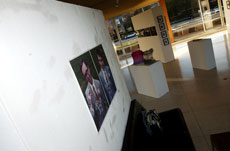Artwork raises censorship question

Online Poster
November 9, 2004
On the first day of the photo exhibit, “It’s not you, it’s me,” University students discovered the view to one of their displays was being obstructed by an 8-inch by 10-inch warning taped on the wall next to the photo.
“Troy the Cunt and Jeremy the Shit,” created by Troy Hayes, junior in FAA, and Jeremy Hayes, sophomore in FAA, is a remake of a 1969 photograph named “George the Cunt and Gilbert the Shit” by Gilbert Proesch and George Passmore, two British artists. The artwork features a photograph of the two brothers, who have the words “George the Cunt” and “Gilbert the Shit” pinned to their suits.
The exhibit, which opened Nov. 3 and will close Nov. 10, is on display at the Art and Design Link Gallery, 408 E. Peabody Drive.
Senior in FAA Lauren Lenkowski, whose work is also displayed, said the department gave students participating in the exhibit full discretion over what pieces would be displayed. She did not recall any previous instances in which the faculty prevented artwork from being displayed because of its content, prior to or after the start of any shows featuring student work.
Lenkowski received an e-mail from University art education professor Elizabeth Delacruz stating that the School of Art and Design Director David Weightman was concerned the artwork’s language could harm the 200 children who use the building during the Saturday Morning Art Program. Weightman could not be reached for comment.
Get The Daily Illini in your inbox!
But Troy Hayes had a hard time accepting Weightman’s reasoning, adding that he and his brother should have been consulted before the warning was put up.
“They just went ahead and did it,” Hayes said. “They didn’t talk to any of our teachers or (us) … Why would they want to censor us? I feel victimized. I’ve seen other shows with penises and testicles … and I don’t recall any controversies whatsoever.”
“Why right now?” Lenkowski said. “Is it because of the word (cunt), because it’s so blatant? I don’t know.”
A person’s potential view of the artwork was obstructed in a variety of ways, Lenkowski said. Signs warning about the language in the Hayes brothers’ work were placed inside the gallery. The wall mounting the artwork was turned away from the outside, and at times another movable wall was placed directly in front of the artwork to keep it from being seen. The artists involved in the exhibit, in response, removed the obstructions to keep the artwork visible.
The conflict seemed like it was going to end Nov. 4, when Ernest Scott, the chair of the Photography Program in FAA, sent out an e-mail containing the conditions agreed upon by the faculty of the School of Art and Design. Scott could not be reached for comment.
According to the e-mail, warnings for “unsuitable” material were to be posted only outside the gallery, and the wall was not to be repositioned except during the hours of the children’s Saturday program.
But the agreements were broken the following day, when the obstructions reappeared. And when Saturday came along, the teachers of the program kept the kids away from the building and the artwork was left unobstructed.
“As it got going, it got funny,” Jeremy Hayes said. “They (were) just blowing it out of proportion.”
Steve Helle, a University journalism professor in media law, said the obstruction of the artwork was not an act of
censorship per se.
“It would not seem to be outright censorship to put a barrier that can be removed by a patron in front of an artwork,” he said.
But Helle said the obstruction was based on the content of the artwork after it was included in the exhibit and, therefore, could raise First Amendment issues.
“It’s one thing to decide what pieces to go on the wall,” Helle said. “It’s another to decide to exclude something based on its content once it’s on the wall.”
Jeremy Hayes understood the concerns for the well-being of the children, but did not think it was a compelling reason for the repeated attempts to censor his artwork throughout the week.
“Children might walk by,” Hayes said. “But we’re at a university, and we don’t have to make artwork for children.”






